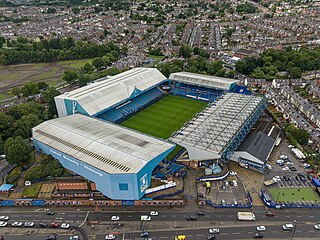
Hillsborough Stadium is a football stadium in the area of Owlerton, Sheffield, South Yorkshire, England. With a total capacity of 39,732, it has been the home of Sheffield Wednesday Football Club since opening in 1899.

Anfield is a football stadium in the area of Anfield, Liverpool, England, which has been the home of Liverpool F.C. since their formation in 1892. The stadium has a seating capacity of 61,276, making it the fifth largest stadium in England. It was originally the home of Everton F.C. from 1884 to 1891, before they moved to Goodison Park after a dispute with the club president.

Molineux Stadium is a football stadium situated in Wolverhampton, West Midlands, England. It has been the home ground of Premier League club Wolverhampton Wanderers since 1889. The first stadium built for use by a Football League club, it was one of the first British grounds to have floodlights installed and hosted some of the earliest European club games in the 1950s.

The City of Manchester Stadium, currently known as Etihad Stadium for sponsorship reasons, is the home of Premier League club Manchester City, with a domestic football capacity of 53,600, making it the 7th-largest football stadium in England and 11th-largest in the United Kingdom.
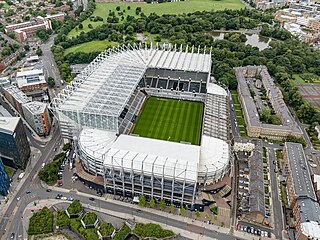
St James' Park is a football stadium in Newcastle upon Tyne, England. It is the home of Newcastle United. With a seating capacity of 52,350 seats, it is the 8th largest football stadium in England.

Old Trafford is a football stadium in Old Trafford, Greater Manchester, England, and is the home of Manchester United. With a capacity of 74,310, it is the largest club football stadium in the United Kingdom, and the twelfth-largest in Europe. It is about 0.5 miles (800 m) from Old Trafford Cricket Ground and the adjacent tram stop.

Pittodrie Stadium, commonly referred to as Pittodrie, from which the surrounding residential area has taken its name, is an all-seater stadium in Aberdeen, Scotland. Used primarily for football, it has been the home ground of the Scottish Professional Football League (SPFL) club Aberdeen F.C. since they were formed in 1903. Prior to then, the ground hosted the original Aberdeen F.C. from 1899 until the merger that created the present club.

Spion Kop is a colloquial name or term for a number of single-tier terraces and stands at sports stadiums, particularly in the United Kingdom. The steep nature resembles the Spion Kop, a hill near Ladysmith, South Africa, which was the scene of the Battle of Spion Kop in January 1900 during the Second Boer War.

White Hart Lane was a football stadium in Tottenham, North London and the home of Tottenham Hotspur Football Club from 1899 to 2017. Its capacity varied over the years; when changed to all-seater it had a capacity of 36,284. The stadium was fully demolished after the end of the 2016–17 season.
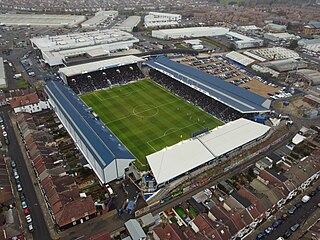
Fratton Park is a football ground in Portsmouth, Hampshire, England, and is the home of Portsmouth Football Club. Fratton Park's location on Portsea Island is unique in English professional football, as it is the only professional English football ground not located on the mainland of Great Britain. Fratton Park has been the only home football ground in Portsmouth F.C.'s entire history.

The Boleyn Ground, often referred to as Upton Park, was a football stadium located in Upton Park, East London. It was the home of West Ham United from 1904 to 2016, and was briefly used by Charlton Athletic in the early 1990s during their years of financial difficulty. The seating capacity of the ground at closure was 35,016.

Headingley Stadium is a stadium complex in Headingley, Leeds, West Yorkshire, England. Linked by a two-sided stand housing common facilities, it comprises the two following separate grounds: Headingley Cricket Ground and Headingley Rugby Stadium.
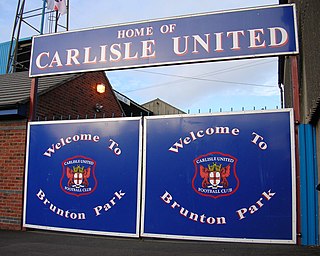
Brunton Park is a football stadium and the home of Carlisle United. It is situated in the city of Carlisle and has a certified capacity of 17,949. The ground opened in 1909. Brunton Park's grandstand burned down in 1953 and the stadium flooded completely in 2005 and again in 2015.

An all-seater stadium is a sports stadium in which every spectator has a seat. This is commonplace in professional association football stadiums in nations such as the United Kingdom, Spain, and the Netherlands. Most association football and American football stadiums in the United States and Canadian Football League stadiums in Canada are all-seaters, as are most baseball and track and field stadiums in those countries. A stadium that is not an all-seater has areas for attendees holding standing-room only tickets to stand and view the proceedings. Such standing areas are known as terraces in Britain. Stands with only terraces used to dominate the football attendance in the UK. For instance, the South Bank Stand behind the southern goal at Molineux Stadium, home of Wolverhampton Wanderers, had a maximum of 32,000 standing attenders, while the rest of the stadium hosted a little bit less than that; the total maximum attendance was around 59,000.
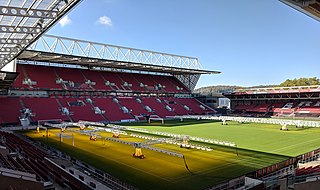
Ashton Gate is a multi-use stadium in Ashton Gate, Bristol, England, and is the home of Bristol City F.C. and the Bristol Bears rugby union team. Located in the south-west of the city, just south of the River Avon, it currently has an all-seated capacity of 26,462.

Glanford Park, currently known as The Attis Arena for sponsorship reasons, is a football stadium in Scunthorpe, Lincolnshire, England, and is the home of National League North team Scunthorpe United.

The County Ground is a football stadium located in Swindon, Wiltshire, England, and has been home to Swindon Town Football Club since 1896. It has an all-seated capacity of 15,728 currently, which has been the same level since the mid-1990s. A record attendance of 32,000 was set on 15 January 1972, against Arsenal in the third round of the FA Cup. North of the football stadium is Swindon Cricket Club, with their pitch also named The County Ground following its use by the football club from 1893 until 1896.

Oakwell is a multi-purpose sports ground in Barnsley, South Yorkshire, England used by Barnsley Football Club for home fixtures, and those of their reserves. As of 2023, the Barnsley F.C. Women's team also play at the stadium.

Damson Park is an association football stadium in Solihull, West Midlands, England. It was the new home of Solihull Borough following their departure from their original Widney Lane Ground. It is now the home of Solihull Moors, the club formed when Solihull Borough and Moor Green merged in 2007. They previously shared Damson Park with Birmingham & Solihull R.F.C. and also used to have an agreement that allows Birmingham City Reserves the use of the ground for their reserve games. Birmingham City W.F.C. of the FA WSL have used Damson Park for home games since 2014.

Headingley Rugby Stadium is a rugby league stadium in Headingley, Leeds and shares the same site as Headingley Cricket Ground. It is the home ground of the Leeds Rhinos. Headingley is the 5th largest rugby league stadium in England.





















